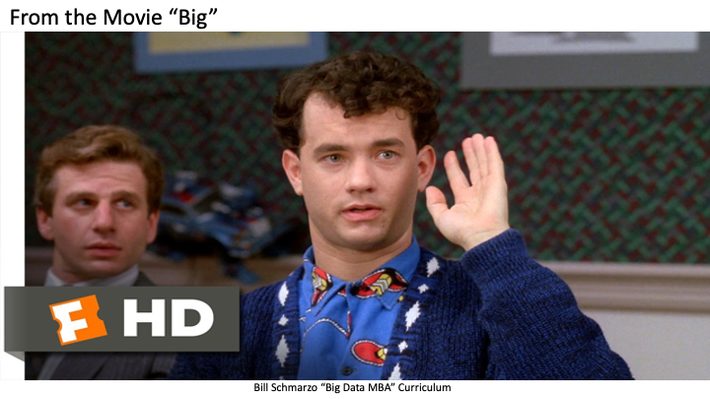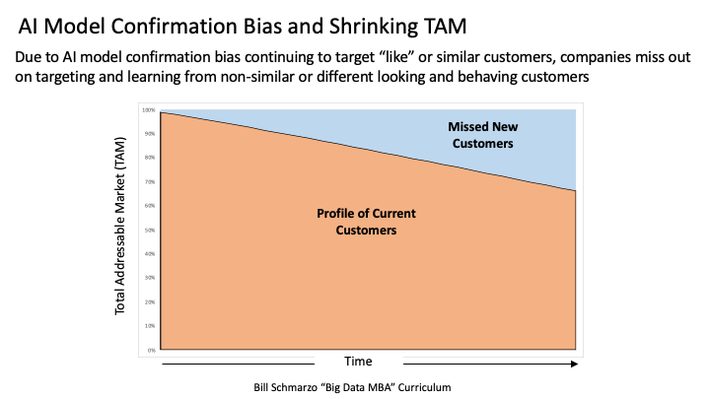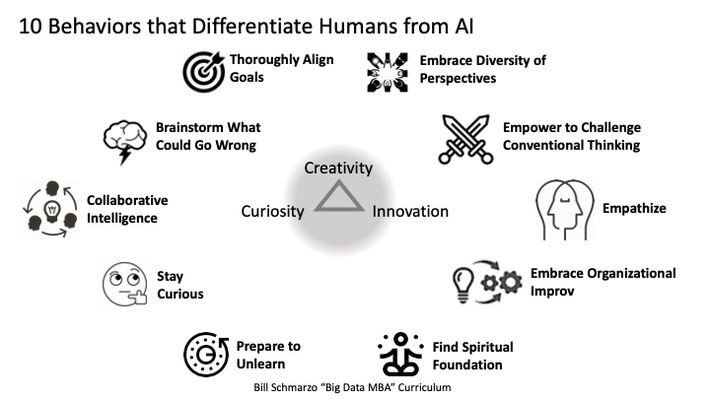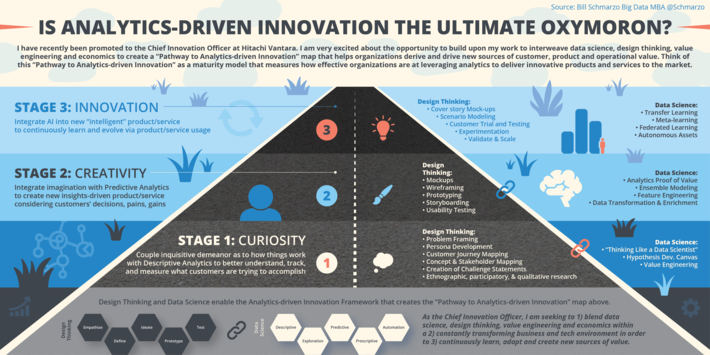
Figure 1: The movie Big: “I don’t get it”
In the blog “What Movies Can Teach Us About Prospering in an AI World – Part 1”, I laid out the challenge that us humans will face surviving in a world dominated by AI. I discussed the different learning techniques – such as machine learning, deep learning, reinforcement learning, and transfer learning – that are available to AI to accelerate its learning. If success in the future is purely defined by how fast one can learn, then us humans are truly doomed.
But are we really doomed? Nah, I think us humans still have a few tricks up our sleeves, but we need to reframe the value that humans will bring to a world of AI.
Tom Hanks to the Rescue
“Big” is one of my favorite movies, and Tom Hanks is one of my favorite actors (though I still want Harrison Ford to play me in my movie). There is lots to like about the movie, but the scene that really sticks with me is when the “adults” are brainstorming about creating a toy that looks like a building but transforms into a robot. Review that scene here:
Josh (Tom Hanks): “I don’t get it.”
Mr. MacMillan (the boss played by Robert Loggia): “What don’t you get, Josh?”
Josh (Tom Hanks): “There’s a million robots that turn into something. This is a building that turns into a robot. What’s fun about playing with a building? That’s not any fun.”
Yes! Us humans aren’t doomed to the dumpster. We still have a role to play in a world driven by AI. But that means we need to channel our inner Tom Hanks (Josh) and be willing to raise our hands when something just doesn’t make sense.
Why Humans Are More Important Than Ever in an AI World
Let’s say a person is applying for a car loan where today those decisions are more and more being made by an AI model. The AI loan application model rejects the applicant because of the applicant’s spotty income history, student loan struggles, and sporadic work history. The AI model assumes that the applicant’s past behaviors is indicative of future outcomes because that is all the AI model has to work with!
Now, a (human) loan officer intercedes on the application process. The loan officer asks the applicant some questions about their intentions for the loan. The applicant explains that they want to buy a nicer car because they want to become an Uber / Lyft / DoorDash driver to generate a more predictable income stream. The loan officer decides to give the loan applicant the loan.
Now, this is a scenario that the AI loan model hasn’t seen in the data, and consequently couldn’t easily extrapolate to ask those questions to make a more informed decision. While the “optimal” choice would have been to reject the loan application, the bigger picture is that if organizations can’t evolve to contemplate these edge cases, over time, they risk shrinking their total addressable market (see Figure 2).

Figure 2: Ethical AI, Monetizing False Negatives and Growing Total Addressable Market
So, what’s the key to embracing our inner Tom Hanks? Here are my top 10 reasons (David Letterman anyone?) for the reason why humans will excel in a world of AI, if we learn to embrace the fact that AI will force humans to become more human.
The 10 Human Behaviors for Humans to Thrive in a World of AI
Not sure why 10 is some magically number (Number of fingers on your hand? Number of frames in bowlin’? Bo Derek?), but here is my list of the top 10 human behaviors that can overcome that massive learning advantage that AI models have over us:

1) Thoroughly Align Goals. Invest the time upfront to thoroughly align and vet goals across a holistic and diverse set of stakeholders. Be sure that everyone is clear on what is trying to be achieved and why it’s important to each stakeholder (a key part of my “Thinking Like a Data Scientist” process). Bring together the different stakeholders – internal and external – who either impact or are impacted by the goals. Brainstorm (and prioritize) the metrics and KPIs against which the team will measure progress and success. Leverage “future visioning” exercises to help all stakeholders to imagine what success looks like…to them.
2) Embrace Diversity of Perspectives. AI models learn by identifying and codifying patterns, trends, and relationships buried in the data. Diversity and outliers are not the friends of an AI model because they can skew the analytic results. And that’s an area where humans can truly excel (if we can learn to overcome our own confirmation biases). Think holistically about the variables and metrics against which you want the AI model to optimize, and not just the financial metrics, but include customer, operational, environmental, societal, and diversity metrics as well. Diversity may be the human secret weapon. Diverse perspectives can create friction and friction can lead to synergizing new ideas. There cannot be innovation without friction. So be inclusive and welcoming of different perspectives.
3) Brainstorm What Could Go Wrong. Empower the naysayers. Bring together folks who support as well as folks who do not support the goals. Brainstorm all the possible ways that things can go wrong. All ideas are worthy of consideration. Invest the time to understand and quantify the costs of the models being wrong. Don’t allow Groupthink, which is the practice of making decisions as a group in a way that discourages creativity or individual responsibility. For a history lesson on Groupthink, check out the Bay of Pigs fiasco.
4) Empower to Challenge Conventional Thinking. Empower everyone to think for themselves and question AI authority (channel your inner Timothy Leary). Embrace the power of “I don’t get it?”. Empower your team members to raise their hands and stand up to challenge the thinking that’s on the table. Embrace an operating model of “Disagree and commit” where folks are allowed to disagree while a decision is being made, but that once that decision is made, everybody must commit to full-on execution of that decision. Be aware of and root out Passive Aggressive behaviors amongst the “Disagree and Commit” crowd. No Pollyannish mentality here.
5) Collaborative Intelligence. Embrace the power of well-aligned, collaborative, diverse teams to bend, break, and blend traditional thinking and approaches into something new and more powerful. Become the master at collaboration. Uncover everyone’s unique assets and synergize the collaboration across those unique assets. Yes, each of us is special (Mister Rogers). Collaborate across different perspectives and experiences to create something greater than the sum of the parts. Resistance is not futile!
6) Empathize. Be more human by being more understanding. Seek first to understand before trying to be understood (Thanks Stephen Covey). Seek to intimately understand your customers. And broaden definition of customers to include all those who you seek to serve, which should include your work colleagues. Embrace empathy, walk in the shoes of others, stand up for what’s right, and truly care about others. Design Thinking provides some marvelous tools if one has the right mindset to truly seek to empathize with their customers.
7) Stay Curious. Innovation is driven by Curiosity. Embrace your inner 5-year-old. Try to understand why things work the way that they do. Don’t be afraid to take apart that radio. Leverage your natural curiosity and turn curiosity into creativity (envision, create, try, fail, learn, re-create, and try again) and turn creativity into innovation. Remember, the base of the word “creativity” is “create”, so don’t be afraid to create or build schtuff. And even if that schtuff doesn’t work, use that as motivation to fuel even more curiosity and create even more schtuff. Build baby, Build!
8) Embrace Organizational Improv. Identify and leverage everyone’s unique “assets” to achieve team and organizational agility. Prepare everyone to lead because at different times in organizational improv, everyone will have to lead. Execute like the US Women’s Olympic Soccer team or a great jazz quartet where everyone is prepared to take their shot or play their riff in sync with the rest of the team. Think expanding team swirls not limiting organizational boxes. Transition from a mindset of compromise to a mindset of abundance where everyone can win, and drive team execution from settling on the “Least Worst” to transforming to “Best Best” decisions.
9) Prepare to Unlearn. Don’t be held captive by your outdated mental models. Don’t be that person who falls back on “That’s the way that we’ve always done it”. Don’t be that guy. The world and capabilities are continuously changing, so challenging your conventional models may be the only way to stay current and valuable. Besides, you can’t climb a ladder if you aren’t willing to let go of the rung below you.
10) Find Your Spiritual Foundation. Ethics must be the foundation for our efforts to become more human. Forgiveness, generosity, caring, compassion. Think about the critical difference between “Do no harm” versus “Do good.” And if you’ve forgotten the difference, re-read the Fable of the Good Samaritan. Be more righteous and sincerely care about others, build for a better future, answer to a higher power. The best textbooks for being more human? The Bible, Torah, Shruti, Koran, or whatever your religious foundation. And finally, when in doubt about the right actions to take, apply the “Mom Test” – that is, what would your mom think if you were to explain your action to your mom (and hopefully your mom isn’t Ma Parker).
Being More Human Summary
AI is going to force us humans to focus on nurturing the creativity and innovation skills that distinctly make us humans and differentiate us from the analytical machines. Innovation and creativity are the human ability and the willingness to be curious, ask provocative and challenging questions (like Tom Hanks in the movie “Big”), embrace diverse ideas and perspectives, blend these different ideas and perspectives into a new perspective (frame), and explore, test, fail, learn, test again, fail again, and learn again in applicability of the new blended perspective to real-world challenges.
Yea, us humans got this.

Figure 3: Is Analytics-driven Innovation the Ultimate Oxymoron?
